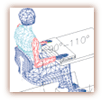Research
& Development
ETC's active Research and Development has created several unique, patented hardware and
software systems for the evaluation and management of ergonomic programs to continually
improve the scientific methods for applied ergonomics.
Technologies & Methods
Ergonomic Technologies Corporation strives to utilize existing resources and provide only
the services necessary to augment internal capabilities for workplace analysis and for
workplace and job improvement. Our research equipment is always state of the art and
currently includes the following to measure the biomechanical exposures produced by work
methods and equipment:
- Cumulative Use Risk Evaluation System
- Portable Measurement Meter (PMM)
- Three Dimensional Human Biomechanical Modeling
- Physiological Work Capacity Predication
- Applied Muscle Effort (Electromyography- EMG) Measurement
- Hand/Wrist and Body Posture Measurement
- Whole Body and Hand Arm Vibration Measurement
- Anthropometric Analysis of "Fit" for Global User Population
- Statistical modeling for human comfort prediction
- Personal Digital Assistant (PDA)
- Computer Systems and Peripherals
Portable Measurement Meter (PMM) "ErgoMeasure III"
ETC has developed and utilizes a PMM device that allow for the simultaneous measurement of
three types of technology. The technologies include;
- Four channels of EMG
- Two 3D Penny & Giles goniometer
channels
- Up to sixteen channels of force sensing
resistors (FSRs)
This device is tethered to a
portable PC that acts as the data logger, no AD/DA board is required.
This type of device has been
used for data collection in the field including fork truck operators during the assessment
of new multifunctional controls, and truck drivers in testing automatic versus manual
transmissions. This product is has also been used in ETCs' product lab for the testing of
various hand and power tools, furniture systems, surgical instruments, and bar code
scanners. This product is not for sale and is used by ETC exclusively. PMM Patent Pending,
ETC, 1996
Three Dimensional Human Biomechanical Modeling
ETC utilizes a computer biomechanical modeling program (University of Michigan 3D Static
Strength to predict the percentage of the population that has the necessary strength
requirements to perform a given task in a fixed (static) posture and to predict the
likelihood of an acute injury. This analysis is also used to determine whether the task
exceeds the back compression design limit (BCDL) or the back compression upper limit
(BCUL) set by the National Institute of Occupational Safety and Health (NIOSH).
Physiological Work Capacity Prediction
ETC uses an energy expenditure model (University of Michigan Energy Expenditure Prediction
Program) based on task activities, gender and operator weight data to estimate metabolic
workload of a job requirement. This data can then be used to determine staffing or rest
requirements for a specific job as well as gauge the effectiveness of solutions in
reducing the overall physiological workload of the job. Portable heart rate monitoring is
often utilized to measure the physiologic response to work-related activities. Performance
information can be recorded over the course of the day at 5 second, 15 second, and 60
second intervals and then downloaded into an IBM compatible computer for long term
analysis.
Applied Muscle Effort Measurement (Electromyography- EMG)
ETC uses multi-surface EMG, a convenient non-invasive method, to measure muscle activity
under different postural and task conditions. This objective data can often help to
identify harmful actions and provide alternative work methods. Mechanical grip
dynamometers are used to measure static strength of individuals in conjunction with EMG
data to aid in the interpretation of the data.
Hand/Wrist and Body Posture Measurement
ETC utilizes digital goniometry for the measurement and recording on a PC of limb angular
movement. The sensors are attached across the joint with medical adhesive tape or are worn
on a flexible wrist splint. This goniometric system is used by ETC to measure
wrist-flexion, extension, ulnar, radial deviation, knee-flexion, extension, hip-flexion,
extension, adduction, abduction, and elbow-flexion, extension. The data is then analyzed
to determine the number of movements and the range of movements induced by a particular
set of job tasks, tools or equipment interface.
To perform a dynamic assessment of work environments and clinical ROM testing, ETC
utilizes a Lumbar Motion Meter (LMM- Chattanooga Group). The LMM was developed to measure
the motion factors that, in combination, cause work-related low back disorders. This
computerized monitoring device can be worn easily by workers on the job site to measure
their trunk motion as they perform their required work tasks.
The LMM measures range of motion, velocity of motion and acceleration of these tasks and
how they affect the lumbar spine. The LMM provides a risk prediction model that is based
on 5 years of research of actual high risk jobs. The LMM can also be used for clinical
testing to measure a patient/employee's range of motion (ROM), velocity and acceleration
for accurate disability determination.
Whole Body and Hand Arm Vibration Measurement
Systems for human vibration analysis for comparison to ANSI, ISO, NIOSH and ACGIH-TLV
standards are used by ETC in aiding in the development of specific exposure guidelines for
a particular task and tool combination. The results from this analysis also allow for a
comparison between various tools and how anti-vibration gloves and other products can
affect the vibration characteristics of the tool operator interface. ETC conducts hand-arm
and whole body vibration assessments.
Anthropometric Analysis of "Fit" for Global User
Population
To evaluate and test the efficacy of design recommendations, ETC uses two humanCAD
modeling systems (Mannequin and Poser) and up to date anthropometric data from various
sources. These systems allow the specification of exact anthropometric requirements for
various body parts and test design alternatives for specific anthropometric populations.
Available populations include 1st through 99th percentile males and females from the U.S.,
Britain, Germany, France, Sweden, Poland, Hong Kong, India, Switzerland and Japan.
Statistical modeling for human comfort prediction
ETC uses sophisticated regression analysis methods and statistical techniques to analyze
the design and use characteristics of a piece of equipment, tool or product. The goal is
to isolate the factors which contribute to user comfort and performance.
|
|




